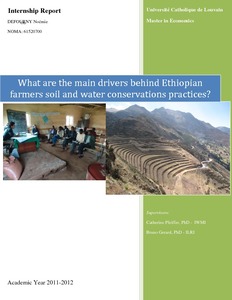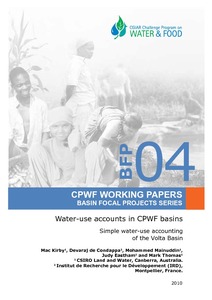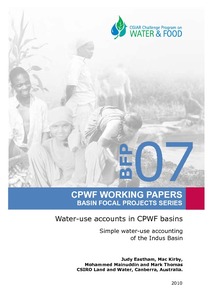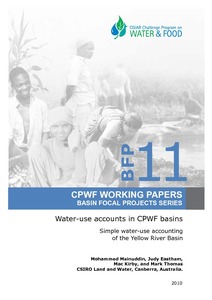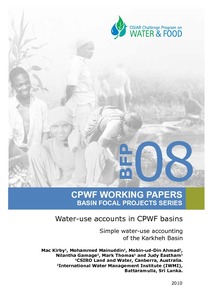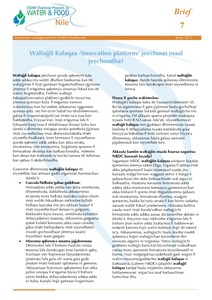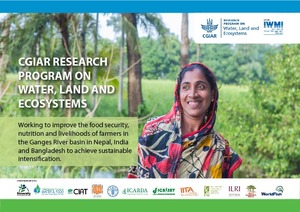Working Paper on Population Growth and Natural Resource Pressures in Pursat Catchment
This project examined the linkages between population and demand for food and water. Cambodia, in general, and Pursat Province in particular, have a complex and interesting mosaic of demographic attributes and development issues. The Tonle Sap basin and Pursat catchment possess the country’s largest potential water resources.
Water-use accounts in CPWF basins: Simple water-use accounting of the Volta Basin
This paper apples the principle of west –use accounts, developed in the first of the series, to the Volta River in West Africa. The Volta Basin covers six countries, with 85% of its area in Ghana and Burkina Faso.
Runoff in all three tributaries increases from 2-7% in the drier north to 12-26 % in the higher – rainfall south. Grassland is the dominant land use throughout Basin ranging from 76% of the Delta catchment in the south to 98% of the Arly catchment with corresponding water use of 55% and 92% of water used in each.
Whose waters? large-scale agricultural development and water grabbing in the Wami-Ruvu River Basin, Tanzania
In Tanzania like in other parts of the global South, in the name of 'development' and 'poverty eradication' vast tracts of land have been earmarked by the government to be developed by investors for different commercial agricultural projects, giving rise to the contested land grab phenomenon. In parallel, Integrated Water Resources Management (IWRM) has been promoted in the country and globally as the governance framework that seeks to manage water resources in an efficient, equitable and sustainable manner.
Water-use accounts in CPWF basins: Simple water-use accounting of the Indus Basin
This paper applies the principles of water-use accounts, developed in the first of the
series, to the Indus River basin in South Asia. The Indus Basin covers 3 countries, rises
in the Tibetan plateau in the vicinity of Lake Mansarovar in China. Irrigated agriculture
in the Basin is extensive with the construction of dams, barrages, and link canals to
distribute water, with modern engineering to support irrigation starting as early as the
mid 1800s.
Net runoff is about 10% of total precipitation. Irrigated agriculture covers 20% of
What determines contribution to a common fund for upkeep of water infrastructures? Evidence from experimental game in Coastal Bangladesh
This interactive poster was presented at the 2013 Stockholm World Water Week. It describes the results of a 'public good game' carried out with farmers in the polder zones of coastal Bangladesh in order to understand determinants of contributions to maintain a public good.
Working Paper on Population Growth and Natural Resources Pressures in Pursat Catchment
This working paper examines population growth in Pursat and its potential impact on food demand and land and water resources in a systematic and integrated manner. The main purpose of the paper is to kick-start a policy debate on population dynamics and food and water security in Pursat. The paper provides background information, observations and empirical analysis of resource demand (real or perceived) associated with population growth and policy decisions related to food and water security.
Water-use accounts in CPWF basins: Simple water-use accounting of the Yellow River Basin
This paper applies the principles of water-use accounts, developed in the first of the
series, to the Yellow River basin in China. The Yellow River rises in the Bayan Har
Mountains in Qinghai Province in western China, and empties into the Bohai Sea. A
unique feature of the river is the large amount of silt it carries.
Net runoff is about 14% of total precipitation. Forest and woodland cover 9% of the
basin and use about 15% of the precipitation. Grassland covers much of the upper part
Water-use accounts in CPWF basins: Simple water-use accounting of the Karkheh Basin
This paper applies the principles of water-use accounts, to the Karkheh River basin in Iran.
The northern part of the Basin where the Karkheh and its tributaries rise is mountainous, cooler, and wetter. The River spills out on to the hotter, lower semi-arid plains at its southern end. Precipitation, mainly in winter, varies from 400-500 mm in the upper part of the Basin falling to about 230 mm in the lower reaches.

